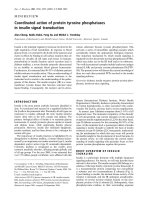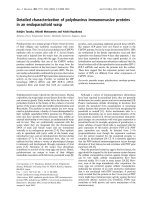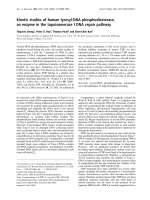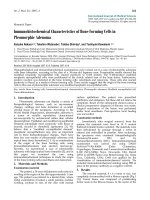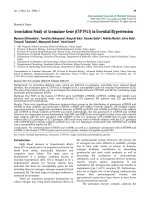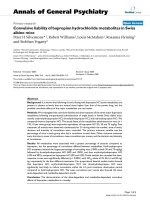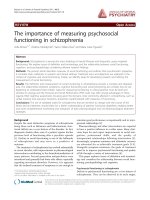Báo cáo y học: " Virological pattern of hepatitis B infection in an HIV-positive man with fatal fulminant hepatitis B: a case report" doc
Bạn đang xem bản rút gọn của tài liệu. Xem và tải ngay bản đầy đủ của tài liệu tại đây (333.37 KB, 7 trang )
BioMed Central
Page 1 of 7
(page number not for citation purposes)
Journal of Medical Case Reports
Open Access
Case report
Virological pattern of hepatitis B infection in an HIV-positive man
with fatal fulminant hepatitis B: a case report
Sabrina Bagaglio
1
, Luca Albarello
2
, Priscilla Biswas
1
, Caterina Uberti-Foppa
1
,
Claudio Fortis
1
and Giulia Morsica*
1
Address:
1
Infectious Diseases Department, San Raffaele, Scientific Institute, Via Stamira d'Ancona, Milano 20127, Italy and
2
Division of Pathology,
San Raffaele, Scientific Institute, Via Olgettina, Milano 20132, Italy
Email: Sabrina Bagaglio - ; Luca Albarello - ; Priscilla Biswas - ;
Caterina Uberti-Foppa - ; Claudio Fortis - ; Giulia Morsica* -
* Corresponding author
Abstract
Introduction: There seem to be no published data concerning the clinical impact of populations
of hepatitis B virus (HBV) in the hepatic and extrahepatic compartments of HIV-infected people
with severe acute hepatitis.
Case presentation: A 26-year-old Caucasian man presenting to our hospital with clinical
symptoms suggesting acute hepatitis was found to have an acute hepatitis B profile upon admission.
He developed fatal fulminant hepatitis and was found to be heavily immunocompromised due to
HIV-1 infection. He had a high plasma HBV and HIV load, and analysis of the partial pre-S1/pre-S2
domain showed the presence of mixed infection with D and F genotypes. Analysis of the point
mutations within this region revealed the presence of HBV strains with amino acid substitutions at
the immunodominant epitopes involved in B or T cell recognition. A homogeneous population of
a pre-core mutant strain harbouring the A1896G and A1899G affecting HBeAg expression was
invariably found in the liver tissue, plasma and peripheral blood mononuclear cells despite active
HBeAg secretion; it was the dominant strain in the liver only, and was characterised by the
presence of two point mutations in the direct repeat 1 domain involved in HBV replication activity.
Taken together, these mutations are indicative of a highly replicative virus capable of evading
immune responses.
Conclusion: This case report provides clinical evidence of a possible association between the
rapid spread of highly replicative escape mutants and the development of fulminant hepatitis in a
heavily immunocompromised patient. Virological surveillance of severe acute hepatitis B may be
important in establishing an early treatment strategy involving antiviral drugs capable of preventing
liver failure, especially in individuals for whom liver transplantation is not accepted as a standard
indication.
Published: 9 November 2009
Journal of Medical Case Reports 2009, 3:110 doi:10.1186/1752-1947-3-110
Received: 5 June 2008
Accepted: 9 November 2009
This article is available from: />© 2009 Bagaglio et al; licensee BioMed Central Ltd.
This is an Open Access article distributed under the terms of the Creative Commons Attribution License ( />),
which permits unrestricted use, distribution, and reproduction in any medium, provided the original work is properly cited.
Journal of Medical Case Reports 2009, 3:110 />Page 2 of 7
(page number not for citation purposes)
Introduction
Various viral mutations have been implicated in the etiol-
ogy and pathogenesis of fulminant hepatitis B (FHB) and
mutations within the pre-core (preC) region of hepatitis B
virus (HBV) have been detected in some cases [1]. The
preC region of the HBV genome is a short open reading
frame (nucleotide 1814-1901) preceding the core gene
that contains the epsilon signal sequence for viral encap-
sidation, which is essential for the start of HBV DNA syn-
thesis [2]. Mutations in this domain could therefore
hamper the mechanism of viral replication. The most fre-
quently encountered point mutation involving the lower
stem of the epsilon structure is the A instead of G muta-
tion at position 1896 that induces a stop codon in the
preC gene, affects HBeAg expression and has been associ-
ated with a severe course of acute hepatitis [3].
An 11-base pair sequence, direct repeat-1 (DR-1), which
starts at nucleotide 1824 of the preC region is directly
repeated near the extremity of the viral plus strand DNA.
It is remarkably well-conserved among different HBV iso-
lates, and the fact that it is necessary for the formation of
plus strand and relaxed circular (RC)-DNA [4] means that
it plays a pivotal role in HBV replication.
Eight genotypes (A-H) have been identified on the basis of
their >8% sequence divergence in the entire genome.
Their distribution varies from country to country, with
genotype D being prevalent in the Mediterranean basin.
Various lines of evidence suggest that HBV may infect
peripheral blood mononuclear cells (PBMCs) [5], which
may therefore represent an extrahepatic site of viral per-
sistence and play a crucial role in exacerbating liver dis-
ease in chronic HBsAg carriers.
We investigated the hepatic and extrahepatic patterns of
HBV infection in a patient who was also infected with HIV
and who was participating in a prospective study of acute
hepatitis B, which fatally evolved into FHB.
Case presentation
A 26-year-old Caucasian man was referred to our hospital
with jaundice and symptoms of general fatigue and ano-
rexia. He denied any known risk factors for potential
exposure to HBV or HIV, including no history of intrave-
nous drug use, surgery, tattoos or piercing. The laboratory
findings upon admission showed a platelet count of 139
× 10
9
/litre and a prothrombin time of 34.4 seconds.
The patient had very few CD4
+
(12 cells/μl) and CD8
+
(323 cells/μl) lymphocytes and a CD4
+
/CD8
+
ratio of
0.04. Blood chemistry tests showed total and direct
bilirubin levels of 1.56 mg/dl and 0.60 mg/dl, respec-
tively, aspartate aminotransferase (AST) 2037 IU/litre,
alanine aminotransferase (ALT) 2317 IU/litre, lactate
dehydrogenase (LDH) 1395 IU/litre and alkaline phos-
phatase (AP) 180 IU/litre. Abdominal sonography
revealed an enlarged liver with a dishomogeneous struc-
ture and normal biliary tree. The patient had an acute hep-
atitis B profile, being positive for HBsAg and HBeAg,
weakly positive for anti-HBc IgM and anti-HBc IgG, and
negative for anti-HBeAb. He was negative for the markers
of acute hepatitis A, hepatitis delta virus, cytomegalovirus
and Epstein-Barr virus, as well as for anti-HCVAb and
HCV RNA, but positive for anti-HIVAb. Western blotting
confirmed a serological profile of chronic HIV infection;
as the patient did not know he was seropositive for HIV,
this was his initial diagnosis with HIV. His sexual partner
was tested and found negative for both HBV and HIV
infection.
Table 1: Characteristics of HBV/HIV co-infection in an HIV-
positive man with FHB.
Admission Before death
HBsAg +++ +++
HBsAg +++ +
HBsAb neg Neg
HBsAb neg Neg
HBcAb (IgM) +/-
a
+++
HBcAb (IgG) neg +
HIV-1 Ab + ND
Antigag Ab pos ND
Antipol Ab pos ND
Anti-env Ab pos ND
CD4
+
cell count
n/μl1211
CD8
+
cell count
n/μl323310
HBV-DNA copies/ml 1.5 × 10
9
5 × 10
8
HIV-RNA copies/ml 3.6 × 10
5
ND
a
+/- = weakly positive; ND = not done.
Journal of Medical Case Reports 2009, 3:110 />Page 3 of 7
(page number not for citation purposes)
Table 1 summarises the sequential serological markers of
HBV/HIV co-infection and the patient's immunological
status.
Over the following week, total bilirubin rapidly increased
to 12 mg/dl, ALT to 3378 IU/l, and AST to 4235 IU/l. His
level of consciousness rapidly deteriorated, coagulation
time became prolonged, and he was diagnosed as having
FHB.
Treatment with lamivudine 200 mg/day was started on
day 12 after hospital admission, but was ineffective and
he died of liver failure 3 days later. The autopsy findings
showed a slightly reduced liver volume and consistency.
Liver histology was scarcely valuable because of massive
necrosis and severe autolithic phenomena.
Plasma HBV DNA was quantified using a real-time
polymerase chain reaction (PCR) assay according to the
manufacturer's instructions (RealArt HBV™ PCR kit; QIA-
GEN Diagnostics GmbH, Hamburg, Germany; lower sen-
sitivity limit: 60 IU/ml = 312 copies/ml). HIV load was
quantified using a branch-DNA assay (Versant HIV-RNA
3.0, Bayer SpA, Milan, Italy). PBMCs (10
6
cells) were iso-
lated by means of Ficoll-Hypaque density-gradient cen-
trifugation and resuspended in 10 ml RPMI 1640 medium
(Lonza-BioWhittaker Verviers, Belgium). Upon admis-
sion, the patient had high plasma levels of HBV DNA and
HIV RNA, and a high HBV DNA load was also found 1 day
before his death (day 14 after hospital admission, Table
1).
HBV DNA was extracted from formalin-fixed paraffin-
embedded liver tissue sections (10 μm), PBMCs and from
200 μl of plasma by means of the QIAamp DNA Mini-kit
(Qiagen SpA, Milan, Italy) following the manufacturer's
instructions.
The HBV genotype was determined by means of the
amplification (hemi-nested PCR) of the partial pre-S1/
pre-S2 region, followed by the sequence analysis of 30
clones. We decided to characterize the HBV genotype by
performing the analysis of clones because the concomi-
tant infection of the same host with different HBV geno-
types is accurately determined by using this molecular
approach.
The preC/C viral population was investigated by sequenc-
ing 18-20 clones propagated from liver, PBMCs and
plasma for a total of 87 clones, in order to explore the
compartmentalisation of the preC mutated strains and
their possible implication in the pathogenesis of the FHB.
A sequence analysis of 26 molecular clones propagated
from plasma revealed mixed HBV D/F genotype infection:
24 clones clustered with genotype D and two with geno-
type F. Detailed sequence analysis showed that the domi-
nant D strain did not show any amino acid (aa) changes,
whereas a minor population clustering with genotype D
showed aa substitution within the immunodominant
epitope responsible for the hepatocyte binding site, and
aa changes in the epitopes recognized by B and T lym-
phocytes (Figure 1). The two clones belonging to geno-
type F showed aa changes in the immunodominant B and
T epitopes, as well as within the hepatocyte binding site
(Figure 1).
A sequence analysis of 20 independent clones propagated
from liver revealed the presence of a homogeneous preC
mutated population showing the A1896G stop codon and
the A1899G substitution, which stabilised the epsilon
structure better, thus avoiding a possible decrease in viral
replication; only three clones had a divergent sequence
with additional nucleotide point mutations. Genetically
related preC mutants harbouring the A1896G substitu-
tion, which prevents the formation of the preC protein,
were found in 19 clones propagated from PBMCs. The
point mutation A1899G, which further stabilises the
structure of the epsilon region by pairing with T1855, was
invariably detected in PBMCs and plasma (Figure 2).
Some of the clones propagated from PBMCs and plasma
were identical, but genetically divergent from those
detected in liver tissue (Figure 2).
Notably, all of the clones from the different compart-
ments had the preC stop codon mutant and the point
mutation A1899G.
Interestingly, a mutant strain with T/C and A/C substitu-
tions at the 5' of the direct repeat (5'-DR1) region, was
invariably found in the clones propagated from the liver
compartment, but was not detected in those propagated
from PBMCs or plasma (Figure 2).
Discussion
HBV is a non-cytopathic virus in which virus-specific
immune responses are thought to play a central role not
only in mediating viral control but also in initiating liver
injury. However, FH occurred in our patient with HIV
despite clinical evidence of his severely immunocompro-
mised status.
To the best of our knowledge, this is the first report of
mixed HBV D/F genotype infection in plasma, and preC
stop codon dominance in different compartments. HBV
genotype F was originally isolated in the Amerindian pop-
ulations of the Americas and is extremely unusual in
Europe [6]. However, our finding is in line with those
published in single reports from Europe and Japan [7,8]
Journal of Medical Case Reports 2009, 3:110 />Page 4 of 7
(page number not for citation purposes)
describing its presence in immunocompetent subjects and
patients infected with HIV.
It is worth noting that we detected aa mutations within
epitopes of the pre-S1 domain, which are important for
attaching the virus to the target cells and for stimulating B
and T cell immune responses [9] in some clones clustering
with genotype D and the two clones clustering with geno-
type F. We hypothesise that these specific aa substitutions
may modify the binding of the virus to its target cells with
a possible effect on virus entry, and may induce a confor-
mational change in B and T cell epitopes that favours the
escape of mutants from the specific immune response.
However, these hypotheses are formed on the basis of the
genetic characteristics of the virus from this one patient
and need to be confirmed by experimental propagation in
animal models or cell lines.
The serological data indicated the presence of HBeAg
despite the detection of a homogeneous population of
preC stop codon mutants, and therefore it is possible that
it was produced by a minor viral population clustering
within genotype F [10].
Two nucleotide substitutions in the 5'-DR1 region, which
is an essential cis element for hepadnaviral reverse tran-
scriptase and immediately precedes the 5'epsilon region,
were detected in all of the clones derived from the liver
compartment. It has been shown that base-pairing inter-
actions in minus strand DNA are critical for efficient
Analysis of the pre-S1 amino acid sequences of 26 clones derived from the plasma sampleFigure 1
Analysis of the pre-S1 amino acid sequences of 26 clones derived from the plasma sample. A minor population
clustering with genotype D showed glutamic acid/aspartic acid (E/D) amino acid substitution within the immunodominant
epitope responsible for the hepatocyte binding site, and lysine/asparagine (K/N), valine/leucine (V/L), asparagine/proline (N/P)
aa changes in the epitopes recognized by B and T lymphocytes. The alignment of clones 1-24 clustering with type D, and clones
25 and 26 clustering with genotype F, was made on the basis of the sequence of the HBV prototype. The numbers in parenthe-
ses refer to the total number of clones with identical amino acid sequences. The empty box indicates identical amino acid; the
black box indicates the amino acid substitution (found in at least nine genotype D clones and the two genotype F clones; the
grey box indicates a randomly detected amino acid mutation; and the striped box indicates an aa deletion. The pre-S1 epitopes
responsible for immune response at T-cell level or thought to contain the hepatocyte binding site are respectively boxed in
black and grey; the asterisk indicates the start of the sequence of the pre-S epitope that elicits the B cell immune response.
Journal of Medical Case Reports 2009, 3:110 />Page 5 of 7
(page number not for citation purposes)
Alignment of the pre-core clone sequences propagated in different compartments and schematic representation of the second-ary structure of the HBV pre-genome encapsidation signalFigure 2
Alignment of the pre-core clone sequences propagated in different compartments and schematic representa-
tion of the secondary structure of the HBV pre-genome encapsidation signal. A) Alignment of the pre-core clone
sequences propagated in different compartments. The alignment was made on the basis of the wild-type sequence of the pre-
genome encapsidation signal. The dashes (-) represent the nucleotides that are identical to the wild-type sequence. B) Sche-
matic representation of the secondary structure of the HBV pre-genome encapsidation signal: base pairing of the lower stem.
The main nucleotide substitutions that better stabilise the epsilon structure detected in the clones derived from liver tissue,
peripheral blood mononuclear cells and plasma are shown in parentheses.
B
A
Journal of Medical Case Reports 2009, 3:110 />Page 6 of 7
(page number not for citation purposes)
primer translocation and RC formation. As RC-DNA
genomes may have a competitive advantage over duplex
linear (DL)-DNA genomes in initiating infection [11], our
finding of nucleotide mutations in DR1 may indicate
reduced complementarity between the RNA primer and
DR2, thus affecting primer translocation, RC formation
and, consequently, viral DNA synthesis. However, there
are no conclusive results concerning the significance of
DL-DNA or RC-DNA production on the virus life cycle.
Several studies have shown that HBV DNA is present in
PBMCs and that HBV may replicate in these cells. The
infection of PBMCs by HBV could interfere with the host's
immune defense against the virus and may support the
establishment of HBV persistence in acute hepatitis B, or
in HBV carriers after liver transplantation, with important
clinical consequences [12,13].
In our case report, the presence of HBV DNA in PBMCs
was shown, and sequence analysis of the preC region
identified HBV strains in PBMCs and plasma that were not
closely related to each other. The most likely explanation
for this is that different plasma and PBMC compartments
may have host biological conditions that differ from those
of the liver, thus leading to the dominance of a well-
adapted variant in these sites of replication.
Finally, it is worth knowing that our FHB patient had a
high HBV DNA titre at baseline one day before he died.
A recent report [14] indicates that treatment for severe
acute hepatitis should be recommended in order to
reduce the risk of progression to FH and the need of organ
liver transplantation.
Unfortunately, treatment with lamivudine was not started
until 12 days after admission, by which time the clinical
condition of this patient had greatly deteriorated.
Conclusion
This is the first report describing a case of acute hepatitis B
with a fulminant course in a heavily compromised HIV-
positive patient showing the dominance of HBV genotype
D over genotype F in plasma, and the selection of preC
mutant strains with different genetic characteristics in
hepatic and extrahepatic sites. It would be interesting to
determine whether this virological pattern may be specif-
ically related to severe FH by extending this analysis to a
larger number of patients with acute severe hepatitis B as
this could add important information for its manage-
ment. In selected cases, early treatment with antiviral
drugs could prevent the need for liver transplantation or
prevent a fatal outcome.
Abbreviations
AA: amino acids; ALT: alanine aminotransferase; AP: alka-
line phosphatase; AST: aspartate aminotransferase; D:
aspartic acid; DL-DNA: duplex linear DNA; DR-1: direct
repeat 1; DR-2: direct repeat 2; E: glutamic acid; FHB: ful-
minant hepatitis B; K: lysine; L: leucine; LDH: lactate
dehydrogenase; N: asparagine; P: proline; PBMC: periph-
eral blood mononuclear cells; RC-DNA: relaxed circular
DNA; V: valine.
Competing interests
The authors declare that they have no competing interests.
Authors' contributions
SB performed, analysed and interpreted the experimental
studies, and made a major contribution to the writing of
the manuscript. LA performed the histological examina-
tion of the liver and actively contributed to writing the
final version of the manuscript. PB gave technical help
and quantified HBV in sequential specimens. CU and CF
collected, analysed and interpreted the clinical data
regarding the acute liver failure. GM was responsible for
designing the study in terms of the clinical and virological
data analysis and made a major contribution to writing
the manuscript.
Consent
Written informed consent could not be obtained in this
case as the patient is dead and his next of kin could not be
traced. However, we believe that this case report contains
a clinical lesson that cannot be effectively conveyed in any
other way. We do not expect the next of kin (or any rea-
sonable person) to object to publication as the patient
cannot be identified.
References
1. Carman WF, Fagan EA, Hadziyannis S, Karayiannis P, Tassopoulos
NC, Williams R, Thomas HC: Association of a pre-core genomic
variant of hepatitis B virus with fulminant hepatitis. Hepatol-
ogy 1991, 14:219-222.
2. Pollack J, Ganem D: An RNA stem-loop structure directs hep-
atitis B virus genomic RNA encapsidation. J Virol 1993,
67:3254-3263.
3. Yotsumoto S, Kojima M, Shoji I, Yamamoto K, Okamoto H, Mishiro
S: Fulminant hepatitis related to transmission of hepatitis B
variants with pre-core mutations between spouses. Hepatol-
ogy 1992, 16:31-35.
4. Rieger A, Nassal M: Specific hepatitis B virus minus-strand
DNA synthesis requires only the 5' encapsidation signal and
the 3'-proximal direct repeat DR1*. J Virol 1996, 70:585-589.
5. Pontisso P, Morsica G, Ruvoletto MG, Zambello R, Colletta C,
Chemello L, Alberti A: Hepatitis B virus binds to peripheral
blood mononuclear cells via the pre S1 protein. J Hepatol
1991, 12:203-206.
6. Norder H, Courouce AM, Magnius LO: Complete genomes, phy-
logenetic relatedness, and structural proteins of six strains of
the hepatitis B virus, four of which represent two new geno-
types. Virology 1994, 198:489-503.
7. Tacke F, Amini-Bavil-Olyaee S, Heim A, Luedde T, Manns MP, Traut-
wein C: Acute hepatitis B virus infection by genotype F
despite successsful vaccination in an immune-competent
German patient. J Clin Virol 2007, 38:353-357.
Publish with Bio Med Central and every
scientist can read your work free of charge
"BioMed Central will be the most significant development for
disseminating the results of biomedical research in our lifetime."
Sir Paul Nurse, Cancer Research UK
Your research papers will be:
available free of charge to the entire biomedical community
peer reviewed and published immediately upon acceptance
cited in PubMed and archived on PubMed Central
yours — you keep the copyright
Submit your manuscript here:
/>BioMedcentral
Journal of Medical Case Reports 2009, 3:110 />Page 7 of 7
(page number not for citation purposes)
8. Shibayama T, Masuda G, Ajisawa A, Hiruma K, Tsuda F, Nishizawa T,
Takahashi M, Okamoto H: Characterization of seven genotypes
(A to E, G and H) of hepatitis B virus recovered from Japa-
nese patients infected with human immunodeficiency virus
type 1. J Med Virol 2005, 76:24-32.
9. Milich DR, Thornton GB, Neurath AR, Kent SB, Michel ML, Tiollais P,
Chisari FV: Enhanced immunogenicity of the pre-S region of
hepatitis B surface antigen. Science 1985, 228:1195-199.
10. De Castro L, Niel C, Gomes SA: Low frequency of mutations in
the core promoter and precore regions of hepatitis B virus
in anti-HBe positive Brazilian carriers. BMC Microbiol 2001,
1:10.
11. Loeb DD, Tian R: Mutations that increase in situ priming also
decrease circularization for duck hepatitis B virus. J Virol 2001,
75:6492-6497.
12. Ferrari C, Penna A, Bertoletti A, Valli A, Antoni AD, Giuberti T, Cav-
alli A, Petit MA, Fiaccadori F: Cellular immune response to hep-
atitis B virus-encoded antigens in acute and chronic hepatitis
B virus infection. J Immunol 1990, 145:3442-3449.
13. Brind A, Jiang J, Samuel D, Gigou M, Feray C, Bréchot C, Kremsdorf
D: Evidence for the selection of hepatitis B mutants after
liver transplantation through peripheral blood mononuclear
cell infection. J Hepatol 1997, 26:228-235.
14. Lisotti A, Azzaroli F, Buonfiglioli F, Montagnani M, Alessandrelli F,
Mazzella G: Lamivudine treatment for severe acute HBV hep-
atitis. Int J Med Sci 2008, 5:309-312.


